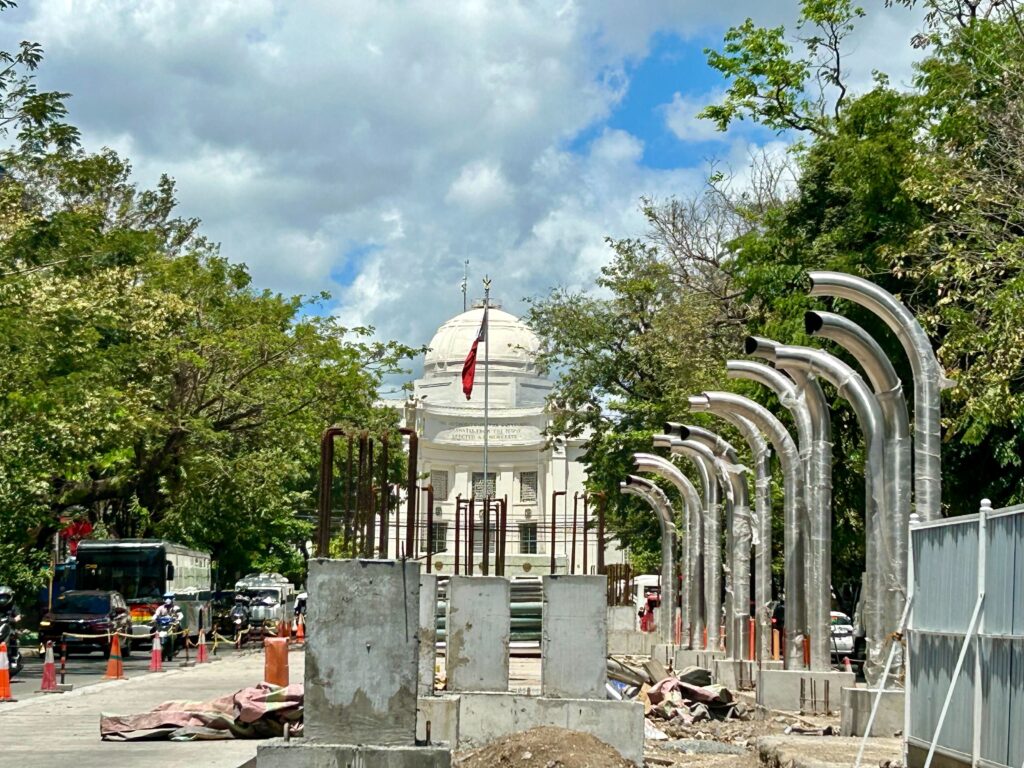CBRT project faces uncertainty amid mismanagement, land disputes

A glimpse of the Cebu Provincial Capitol amidst the construction of a bus station for the Cebu Bus Rapid Transit (CBRT) project along Osmeña Boulevard. CDN Digital File Photo
CEBU CITY, Philippines – The Cebu Bus Rapid Transit (CBRT) was originally designed to ease city traffic but now faces problems due to project mismanagement and land disputes, causing uncertainty of the project’s future.
Experts found fault with how the Department of Transportation (DOTr) managed the project, while local politics added more problems.
Engineer Rene Santiago, an authority on urban planning, raised three potential futures for the CBRT: persisting with flaws, halting the project to cut losses, or finding compromises that may not fully solve issues.
READ: TIMELINE: The Cebu Bus Rapid Transit
In an interview on April 3, after the executive session of the Cebu City Council, Santiago criticized the DOTr’s management over the past ten years, blaming “incompetence” for repeated setbacks.
He suggested two options: scaling down the project, likely to fail due to traffic, or pushing for the full line within six months.
Additionally, Santiago highlighted accessibility issues with the project’s design, especially for elderly commuters, who might find the proposed pedestrian infrastructure inconvenient. He likened the suggested crosswalks and underpasses to a “punishment” for users.
He added, “The removal of two skywalks in the city without providing adequate pedestrian facilities will only exacerbate traffic congestion.”
Santiago emphasized the importance of making the BRT system user-friendly to ensure its success.
He expressed doubts to the World Bank in 2014 about the DOTr’s ability to oversee the project, citing technical and administrative hurdles that could lead to failure.
He highlighted Escario Street to the IT Park route as problematic for maintaining exclusive bus lanes but noted potential in other areas.
Santiago suggested that the City of Cebu, as the project initiator, should directly manage its execution.
Santiago also flagged challenges with Public Utility Vehicles (PUVs) operations, especially due to the BRT’s overlap with the PUV modernization program, causing complications with franchises.
Urban planner Engineer Paul Villarete, who supported the BRT since 2008, expressed disappointment with its changes over time. Despite this, he’s hopeful, especially about the Bulacao to Ayala line, seen as more practical than the original plan.
READ: Gwen orders to halt Cebu BRT construction in heritage buffer zones
Meanwhile, in a recent press conference, Governor Gwendolyn Garcia clarified that her February 27 memorandum only focused on building bus stations on province-owned lands along Osmeña Boulevard, not the entire BRT project.
She explained her objection to the bus stations’ placement, not the entire BRT project. Additionally, Garcia provided land titles to prove the province’s ownership of the areas designated for the BRT infrastructure.
“Klaruhon ta ni ha, sabta palihug. Wa gyoy nag-ingon undanga ang BRT. Ang akong giingon, ang bus stations,” she said.
READ: Rama asks Malacañang to suspend Gwen over CBRT dispute
Last March 20, Rama filed a legal complaint before the Office of President Ferdinand Marcos Jr. against the Garcia after the governor issued a cease and desist order to the CBRT project, in which she cited heritage concerns as grounds for it.
On March 20, Mayor Rama filed a legal complaint against Garcia before the Office of President Ferdinand Marcos Jr.
This was in response to Garcia issuing a cease and desist order to the CBRT project, citing heritage concerns.
The mayor accused Garcia of abusing her authority and committing acts of abuse, oppression, and grave misconduct, arguing that she had no jurisdiction to interfere with Cebu City’s affairs, as it operates independently as a Highly Urbanized City (HUC). /clorenciana
Disclaimer: The comments uploaded on this site do not necessarily represent or reflect the views of management and owner of Cebudailynews. We reserve the right to exclude comments that we deem to be inconsistent with our editorial standards.
